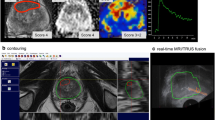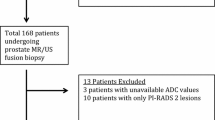Abstract
Purpose
This study evaluated the accuracy of MR sequences [T2-, diffusion-weighted, and dynamic contrast-enhanced (T2WI, DWI, and DCE) imaging] at 3T, based on the European Society of Urogenital Radiology (ESUR) scoring system [Prostate Imaging Reporting and Data System (PI-RADS)] using MR-guided in-bore prostate biopsies as reference standard.
Methods
In 235 consecutive patients [aged 65.7 ± 7.9 years; median prostate-specific antigen (PSA) 8 ng/ml] with multiparametric prostate MRI (mp-MRI), 566 lesions were scored according to PI-RADS. Histology of all lesions was obtained by targeted MR-guided in-bore biopsy.
Results
In 200 lesions, biopsy revealed prostate cancer (PCa). The area under the curve (AUC) for cancer detection was 0.70 (T2WI), 0.80 (DWI), and 0.74 (DCE). A combination of T2WI + DWI, T2WI + DCE, and DWI + DCE achieved an AUC of 0.81, 0.78, and 0.79. A summed PI-RADS score of T2WI + DWI + DCE achieved an AUC of 0.81. For higher grade PCa (primary Gleason pattern ≥ 4), the AUC was 0.85 for T2WI + DWI, 0.84 for T2WI + DCE, 0.86 for DWI + DCE, and 0.87 for T2WI + DWI + DCE. The AUC for T2WI + DWI + DCE for transitional-zone PCa was 0.73, and for the peripheral zone 0.88. Regarding higher-grade PCa, AUC for transitional-zone PCa was 0.88, and for peripheral zone 0.96.
Conclusion
The combination of T2WI + DWI + DCE achieved the highest test accuracy, especially in patients with higher-grade PCa. The use of ≤2 MR sequences led to lower AUC in higher-grade and peripheral-zone cancers.
Key Points
• T2WI + DWI + DCE achieved the highest accuracy in patients with higher grade PCa
• T2WI + DWI + DCE was more accurate for peripheral- than for transitional-zone PCa
• DCE increased PCa detection accuracy in the peripheral zone
• DWI was the leading sequence in the transitional zone




Similar content being viewed by others
Abbreviations
- ESUR:
-
European Society of Urogenital Radiology
- PI-RADS:
-
Prostate Imaging Reporting and Data System
- mp-MRI:
-
Multiparametric magnetic resonance imaging
- DCE:
-
Dynamic contrast-enhanced imaging
- MRSI:
-
Magnetic resonance spectroscopic imaging
- DWI:
-
Diffusion-weighted imaging
- ROC:
-
Receiver operating characteristic
- AUC:
-
Area under the curve
- PCa:
-
Prostate cancer
- PSA:
-
Prostate-specific antigen
- TRUS:
-
Transrectal ultrasound
References
Murphy G, Haider M, Ghai S et al (2013) The expanding role of MRI in prostate cancer. AJR 201:1229–1238
Barentsz JO, Richenberg J, Clements R et al (2012) ESUR prostate MR guidelines 2012. Eur Radiol 22:746–757
Mozer P, Cornud F, Renard-Penna R, Misrai V, Thoulouzan M, Malavaud B (2012) Validation of the European Society of Urogenital Radiology scoring system for prostate cancer diagnosis on multiparametric magnetic resonance imaging in a cohort of repeat biopsy patients. Eur Urol 62:986–996
Kuru TH, Roethke MC, Rieker P, Roth W, Fenchel M, Hohenfellner M, Schlemmer HP, Hadaschik BA (2013) Histology core-specific evaluation of the European Society of Urogenital Radiology (ESUR) standardised scoring system of multiparametric magnetic resonance imaging (mpMRI) of the prostate. BJU Int 112:1080–1087
Schimmöller L, Quentin M, Arsov C, Lanzman RS, Hiester A, Rabenalt R, Antoch G, Albers P, Blondin D (2013) Inter-reader agreement of the ESUR score for prostate MRI using in-bore MRI-guided biopsies as the reference standard. Eur Radiol 23:3185–3190
Rosenkrantz AB, Lim RP, Haghighi M, Somberg MB, Babb JS, Taneja SS (2013) Comparison of interreader reproducibility of the prostate imaging reporting and data system and Likert scales for evaluation of multiparametric prostate MRI. AJR 201:601–618
Westphalen AC, Rosenkartz AB (2014) Prostate Imaging Reporting and Data System (PI-RADS): reflections on early experience with a standardized interpretation scheme for multiparametric prostate MRI. AJR 202:121–123
Mazaheri Y, Shukla-Dave A, Muellner A et al (2008) MR imaging of the prostate in clinical practice. MAGMA 21:379–392
Osugi K, Tanimoto A, Nakashima J, Shinoda K, Hashiguchi A, Oya M, Jinzaki M, Kuribayashi S (2013) What is the most effective tool for detecting prostate cancer using a standard MR scanner? Magn Reson Med Sci 12:271–280
Puech P, Sufana-Iancu A, Renard B, Lemaitrea L (2013) Prostate MRI: can we do without DCE sequences in 2013? Diagn Interv Imaging 94:1299–1311
Sabach A, Babb JS, Matza BW, Taneja SS, Deng FM (2013) Prostate cancer: comparison of dynamic contrast-enhanced MRI techniques for localization of peripheral zone tumor. AJR 201:471–478
Hoeks CMA, Hambrock T, Yakar D, Hulsbergen-van de Kaa CA, Feuth T, Witjes JA, Fütterer JJ, Barentsz JO (2013) Transition zone prostate cancer: detection and localization with 3-T multiparametric MR imaging. Radiology 266:207–217
Dickinson L, Ahmed HU, Allen C, Barentsz JO, Carey B et al (2011) Magnetic resonance imaging for the detection, localization and characterisation of prostate cancer: recommendations from a European consensus meeting. Eur Urol 59:477–494
Quentin M, Schimmöller L, Arsov C, Rabenalt R, Antoch G, Albers P, Blondin D (2013) Increased signal intensity of prostate lesions on high b-value diffusion-weighted images as a predictive sign of malignancy. Eur Radiol 24:209–213
Röthke M, Blondin D, Schlemmer HP, Franiel T (2013) PI-RADS classification: structured reporting for MRI of the prostate. Röfo 185:253–261
Dickinson L, Ahmed HU, Allen C, Barentsz JO, Carey B, Futterer JJ, Heijmink SW, Hoskin P, Kirkham AP, Padhani AR, Persad R, Puech P, Punwani S, Sohaib A, Tombal B, Villers A, Emberton M (2013) Scoring systems used for the interpretation and reporting of multiparametric MRI for prostate cancer detection, localization, and characterization: could standardization lead to improved utilization of imaging within the diagnostic pathway? J Magn Reson Imaging 37:48–58
Siddiqui MM, Rais-Bahrami S, Truong H, Stamatakis L, Vourganti S, Nix J, Hoang AN, Walton-Diaz A, Shuch B, Weintraub M, Kruecker J, Amalou H, Turkbey B, Merino MJ, Choyke PL, Wood BJ, Pinto PA (2013) Magnetic resonance imaging/ultrasound-fusion biopsy significantly upgrades prostate cancer versus systematic 12-core transrectal ultrasound biopsy. Eur Urol 64:713–719
Delongchamps NB, Rouanne M, Flam T et al (2011) Multiparametric magnetic resonance imaging for the detection and localization of prostate cancer: combination of T2-weighted, dynamic contrast-enhanced and diffusion-weighted imaging. BJU Int 107:1411–1418
Nagel KN, Schouten MG, Hambrock T, Litjens GJ, Hoeks CM, ten Haken B, Barentsz JO, Fütterer JJ (2013) Differentiation of prostatitis and prostate cancer by using diffusion-weighted MR imaging and MR-guided biopsy at 3 T. Radiology 267:164–172
Donati OF, Jung SI, Vargas HA, Gultekin DH, Zheng J, Moskowitz CS, Hricak H, Zelefsky MJ, Akin O (2013) Multiparametric prostate MR imaging with T2-weighted, diffusion-weighted, and dynamic contrast-enhanced sequences: are all pulse sequences necessary to detect locally recurrent prostate cancer after radiation therapy? Radiology 268:440–450
Isebaert S, Van den Bergh L, Haustermans K et al (2013) Multiparametric MRI for prostate cancer localization in correlation to whole-mount histopathology. J Magn Reson Imaging 37:1392–1401
Chesnais AL, Niaf E, Bratan F, Mège-Lechevallier F, Roche S, Rabilloud M, Colombel M, Rouvière O (2013) Differentiation of transitional zone prostate cancer from benign hyperplasia nodules: evaluation of discriminant criteria at multiparametric MRI. Clin Radiol 68:323–330
Hoeks CMA, Vos EK, Bomers JGR, Barentsz JO, Hulsbergen-van de Kaa CA, Scheenen TW (2013) Diffusion-weighted magnetic resonance imaging in the prostate transition zone. Histopathological validation using magnetic resonance guided biopsy specimens. Investig Radiol 48:693–701
Acknowledgments
The scientific guarantor of this publication is Dirk Blondin. The authors of this manuscript declare no relationships with any companies, whose products or services may be related to the subject matter of the article. The authors state that this work has not received any funding. No complex statistical methods were necessary for this paper. Institutional Review Board approval was obtained. Written informed consent was obtained from all patients in this study. No study participants or cohorts have been previously reported. Methodology: retrospective, diagnostic or prognostic study, performed at one institution.
Author information
Authors and Affiliations
Corresponding author
Rights and permissions
About this article
Cite this article
Schimmöller, L., Quentin, M., Arsov, C. et al. MR-sequences for prostate cancer diagnostics: validation based on the PI-RADS scoring system and targeted MR-guided in-bore biopsy. Eur Radiol 24, 2582–2589 (2014). https://doi.org/10.1007/s00330-014-3276-9
Received:
Revised:
Accepted:
Published:
Issue Date:
DOI: https://doi.org/10.1007/s00330-014-3276-9




